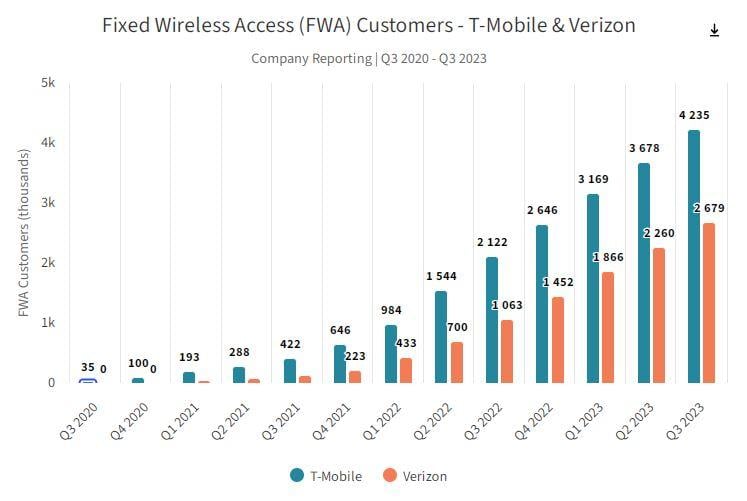For T-Mobile and Verizon, fixed wireless access (FWA) is the gift that keeps on giving in the 5G era.
Despite strong customer growth, both T-Mobile and Verizon have maintained performance levels over the past year, according to Ookla’s Speedtest data.
That’s noteworthy given rivals’ contention that their networks can’t handle the demands of home broadband users because their networks are built for mobile rather than fixed users. Both T-Mobile and Verizon say they vet FWA customers to make sure there’s adequate capacity for everybody.

T-Mobile and Verizon have been steadily growing FWA customers. At the end of the third quarter, T-Mobile was serving more than 4.2 million customers with its FWA product. Verizon’s total FWA subscriber base was about 2.7 million.
Ookla found that both T-Mobile and Verizon recorded similar median download speeds in Q3 2023, although T-Mobile maintains an edge on median upload performance.
Ookla looked at its Speedtest data to identify users that had churned since Q2 2022, when FWA services really started to scale and impact the rest of the market. The bulk of churn to both T-Mobile’s and Verizon’s 5G FWA services are coming from cable and DSL providers, confirming what the service providers have said.
The market research firm said that performance on T-Mobile’s and Verizon’s 5G FWA services has held up well to date, although it lags behind median download performance of the major cable and fiber ISPs.
Ookla clocked the median download speed across the U.S. for all fixed providers combined in Q3 2023 at 207.42 Mbps. T-Mobile recorded consistent median download speed over the past four quarters, reaching 122.48 Mbps in Q3 2023 based on Speedtest data, but saw its median upload performance erode slightly, from 19.76 Mbps in Q4 2022 to 17.09 Mbps in Q3 2023.
Meanwhile, Verizon improved its median download performance when compared to Q4 2022, reaching a similar level to T-Mobile, of 121.23 Mbps in Q3 2023. However, its upload performance remained lower than T-Mobile’s, at 11.53 Mbps, Ookla said.
Regional differences
While median performance has remained fairly steady for both operators over the past year, Ookla said it’s a different story when it comes to regional performance and between urban and rural regions.
Rural locations – predictably – fared worse than urban locations for both T-Mobile and Verizon 5G FWA service, given differences in spectrum availability and distance from cell sites, although the difference was starker for Verizon’s FWA service, Ookla said. Verizon’s FWA service recorded a median of 155.77 Mbps in urban locations during Q3 2023, but only 51.41 Mbps in rural locations.
T-Mobile increased rural FWA performance, from 82.20 Mbps in Q4 of 2022 to 91.96 Mbps in Q3 2023. Verizon’s performance in urban locations improved, with the 155.77 Mbps it achieved in Q3 2023 representing a sizable increase on the 125.55 Mbps it recorded in Q4 2022.
All of the big mobile operators, including AT&T with Internet Air, will see improved 5G FWA performance with additional C-band spectrum, and T-Mobile could potentially use millimeter wave on its 5G standalone (SA) network for FWA, Ookla noted.